Introduction
Research on cognitive learning has suggested that visual stimuli can nurture strong memory connections (Shapiro & Waters, 2005). Several techniques that use mnemonic devices have yielded positive outcomes. Rieder-Bünemann (2012, p. 2291) refers to mnemotechnics as tools that can aid memorization by relying on associations between the items to be remembered and other entities, which will help with storing and recalling. For example, acronyms (a made-up combination of letters with each letter acting as a cue to an idea) and chaining (creating a story where each word or idea to be remembered provides a cue for the next idea to be recalled) have been found to help with recall (OżaÅ„ska-Ponikwia, 2015). The reason for this might be that mnemonic techniques make use of empirical principles that have been found to improve learning and long-term retention, namely, senses, movement, association, structure, imagery, and imagination (Zahedi & Fallah, 2011). Mnemonics techniques have been assessed in different educational contexts such as mathematics, and findings have underscored the effectiveness of memorizing mathematical concepts and procedures using mnemonic techniques in problem solving tasks (Miller & Obara, 2017). Furthermore, mathematical mnemonics have been widely used and found to increase performance and understanding, particularly within special education populations (Kavale & Forness, 2000).
The Keyword Method and L2 Vocabulary Learning
In L2 research, mnemonics has been regarded as a very relevant factor in the development of vocabulary learning (Sagarra & Alba, 2006). Indeed, vocabulary knowledge is a key component in enhancing communicative competence as it involves knowledge of the components of lexical items, lexical organization, receptive and productive mastery, and fluency (Schmitt, 2014). A mnemonic technique that has been used in L2 vocabulary learning is the Keyword Method(KM). This method involves associating a new word with an L1 word that is similar in pronunciation (the keyword); that is to say, both words share acoustic similarity (Atkinson & Raugh, 1975). A mental image is then formed to link the unfamiliar word to the keyword, and the strength of this association will affect the extent to which recall is successful. As Shapiro and Waters (2005) state, the depth of processing and the number of mental links that can be established between existing knowledge and the new lexical item can ensure that new information is committed to long-term memory. In L2 vocabulary learning, the learner must first acquire a stable association between the unfamiliar foreign word and a familiar L1 word that shares an acoustic similarity with the L2 word. The learner then encodes a meaningful interaction between the keyword and the foreign word definition. An example for this is provided below. For the L2 word “cart”, an adequate L1 keyword for it would be “carta” (letter). Then, a meaningful interaction that involves the keyword (carta) and the L2 item (cart) is created. This step can be achieved by providing a visual cue to learners, by offering a meaningful sentence linking both items, or by asking them to generate their own interactive visual image in their minds. Thus, for the word “cart”, a visual cue can be created by associating a shopping cart in which a letter is being carried

Figure 1: KM example: Carta (L1) - Cart (L2)
A central psychological theory underpinning the KM is the dual-coding theory proposed by Paivio (1971). This theory postulates that both visual and verbal codes can be used to represent information. The theory also states that there are two cognitive subsystems: the analogue code and the symbolic code. While the former is specialized in the representation and processing of non-verbal objects/events that retain the main characteristic features of objects (imagery), the latter specializes in dealing with language, i.e., forming mental representations of symbols such as words (Cuevas & Dawson, 2018). A flood of linguistic stimuli can prompt a learner into “cognitive overload”, which leads to discarding information from memory and lower retention. On the other hand, visual information can be stored separately without producing such mental overload, thus creating an additive effect which can lead to greater retention. Indeed, visual prompts that engage dual coding are thought to produce higher levels of retention because two representations of the stimuli are stored in long-term memory (Hodes, 1998).
Mental imagery is a crucial concept in mnemonics and the KM. It is one of the primary human mental abilities that allow individuals to remember, plan for the future, and make decisions (Pearson et al, 2015). However, its potential as a learning method has not yet been fully explored (Rieder-Bunemann, 2012). There is evidence that mental imagery can be nurtured by means of verbal information. Schunk (2012) identified ways to prompt learners to use mental imagery, such as having learners close their eyes and visualize the concept or word to be learned. In line with this, Algozzine and Douville (2004) claimed that mental imagery is best served when it seeks to facilitate deep engagement in reading, generate descriptive words in writing, and concretize abstract mathematical concepts. When word retention is sought, it must be noted that more abstract lexical items may be harder to visualize than concrete words. As Ellis and Beaton (1993) reasoned, keywords that are less “imageable” (i.e., verbs) reduce the effectiveness of the KM, while nouns that are highly imageable (i.e., concrete nouns) prompt the most solid associations. As the chain of associations is formed, they allow the storage of information in memory in such a way that the brain is able to find the required information and retrieve it when necessary (Higbee, 2001).
Empirical Studies on the KM and L2 Vocabulary
A number of researchers have reported the benefits of KM in L2 vocabulary learning and retention (Davoudi & Yousefi, 2016; Fritz et al., 2007; Sagarra & Alba, 2006). In these studies, almost all the groups being exposed to KM techniques showed improvement in immediate and delayed post-test measures when compared to control group performance (Marland, 2002). Sagarra and Alba (2006) showed that vocabulary learning techniques such as KM, which require deeper processing through form and meaning, yielded more retention. Likewise, Sarıçoban and Başıbek (2012) compared the effects of mnemonics and the context method (that is, providing context by means of sentences and words surrounding the unknown words). They divided 84 upper-intermediate ESP Turkish learners into a KM group and a context method group. Results for immediate and delayed tests revealed that mnemonic techniques were more effective than the context method on both recall and recognition tests. The KM has been found to be more effective than the word list condition method (Baleghizadeh & Ashoori, 2010), and the whole word proofreading technique, a well-known vocabulary learning method that relies on recognition and making inferences within the text (Shaman, 2011). Nonetheless, Shapiro and Waters (2005) noted that the effectiveness requires that the lexical items to be taught be highly imageable. Less imageable words, such as verbs, may reduce the effectiveness of the method. Furthermore, a decision needs to be made on whether learners should create their own keyword, or whether teachers should provide them. The literature reports that learners may struggle to create their own mnemonic system, so teachers should device and provide the adapted mnemonics from various sources in order to suit diverse types of learners and enhance their learning process (Marland, 2002). As Luo and Huang (2019) state, methods based on rote repetition are not engaging enough for most learners, so mnemonic techniques such as the KM appear as more appealing to learners. This may be particularly true with low-proficiency learners as they have been found to learn more L2 vocabulary when they create acoustic links and a mental image (Shapiro & Waters, 2005). Overall, there is a consistent body of research evidencing the superiority of KM when compared to other L2 vocabulary learning methods. It becomes necessary, then, to seek ways to compare approaches to learning that focus on specific cognitive processes in the KM that can affect vocabulary learning in the EFL language classroom.
The present research study sought to assess the extent to which visual images affect the creation of mental imagery and the learning and retention of lexical items. To this end, two versions of the KM containing different types of mental imagery prompts were created: a version with visual cues, and a version without visual cues. A comparison group that completed Rote Learning tasks was also included. Thus, the study sought to evaluate whether the two versions of the KM were more beneficial to learners than the comparison group in the learning and retention of lexical items.
Methodology
Overall Study Design
This study has a quasi-experimental design that included three intact classes. The participants are 37 adult EFL students majoring at a private university in Santiago, Chile. They were divided into three groups: the KM+visual cues (n=15), the KM with no visual cues (n=14), and the comparison group with Rote Learning (n=8) learners. Knowledge of 15 unknown target words was assessed once the treatment was applied. The main study consists of a pilot study and three sessions, which were carried out over five weeks. The research questions are as follows:
RQ1: Does a version of the Keyword Method involving visual cues promote more vocabulary learning and retention in EFL learners than a version without them?
RQ2: Does the Keyword method promote more vocabulary learning and retention than Rote Learning in EFL learners?
Research question 1 sought to assess the effectiveness of visual cues in the KM in terms of vocabulary learning and retention gains. To this end, learners were exposed to two versions of the KM that included different approaches to mental imagery. The KM+visual cues group received a KM treatment that included visual cues provided by the researchers while learners in the KM with no visual cues group created their own mental images for the unknown words. Research question 2 assessed whether the KM (with or without visual cues) was more effective than the Rote Learning method (comparison group) in the vocabulary learning and retention gains of these EFL learners.
Participants
For this study, 37 EFL lower intermediate learners from a private university majoring in journalism were asked to participate once a measure of general language proficiency was applied. Participants who belonged to A2-B1 level according to the Common European Framework of Reference for Languages (CEFR) were included in the study. The Oxford Quick Placement Test (University of Cambridge Local Examinations Syndicate, 2001) was administered to assess baseline proficiency and control for group equivalence in this respect. The OQPT is a valid and reliable test that measures the learner’s English language proficiency according to the CEFR and represents an effective way to assess a learner’s level of English (Geranpayeh, 2003). The OQPT confirmed that the 37 participants belonged to the A2-B1 proficiency bands selected for the study.
The present study has as a background a Chilean EFL learning setting. In Chile, learners are exposed to English (114 hours per year) starting from 5th grade until 12th grade when they complete their secondary education (Cancino, 2020). The Chilean governments have tried to position the country as a bilingual nation that is a competitive actor in a globalised market (Barahona, 2015; Glas, 2008). Thus, the four linguistic skills (Listening, Speaking, Reading, and Writing) are emphasised in the classroom, and guidelines suggest that L2 should be used extensively in the classroom (Ministerio de Educación República de Chile, 2016). Even though particular programmes—such as the English Opens Doors initiative—have been introduced by the Ministry of Education in order to provide continuing education for teachers and extra-curricular activities for learners (Matear, 2008), performance in international proficiency tests suggests that Chilean learners are lagging behind other countries in Latin America (Gómez & Pérez, 2015). Curricular factors such as the insufficient number of hours allocated to learning English in municipal schools (Díaz Larenas & Morales Campos, 2015) and contextual factors such as the linguistic heterogeneity of the classrooms (Muñoz & Mora, 2006) may explain such results.
Materials and Instruments
Target Words
In order to identify 15 unknown target items, 30 words were selected from the 4000-6000 most frequent words in the BNC corpus by means of Lextutor, an online tool that provides a number of vocabulary analysis features. The selected words were concrete, content words which can be perceived by using the senses (Nation, 2001). This selection was necessary to create the KM treatment as concrete words can prompt the creation of mental images more easily. In addition, these words had to allow for the creation of L1 acoustic links for the KM treatment. An adapted version of the vocabulary knowledge scale (VKS) was used so that participants could report their level of knowledge regarding these 30 words. The VKS is an instrument that measures vocabulary knowledge and has categories “to capture initial stages or levels in word learning that are subject to accurate self-report of efficient demonstration” (Wesche & Paribakht, 1996, p. 33). The instrument starts from “complete unfamiliarity, through recognition of the word and some ideas of its meaning, to the ability to use the word with grammatical accuracy in a sentence” (Wesche & Paribakht, 1996, p. 29). The first two levels are answered by self-report whereas the other three require that learners provide distinct levels of information on the meaning of a given word. The VKS has been criticized due to its use of decontextualized prompts and in relation to the validity of the scores that display partial knowledge increments (Bruton, 2009). While these criticisms are warranted, in the present study the VKS was not used as a post-test measure, but it was adapted so that participants would identify 15 target words that were unknown to them before the intervention. Therefore, participants were handed out a modified version of VKS that asked them to recognize 30 lexical items in order to gather their knowledge of the words and identify 15 target words. Participants selected one of the three options given (1. I do not remember seeing this word; 2. I have seen this word before, but I do not know what it means; 3. I have seen this word before and I think it means _____). The 37 participants in the study selected the first choice for the 15 target words used in the treatment. Table 1 below presents the 15 unknown target words as reported by participants in the VKS:
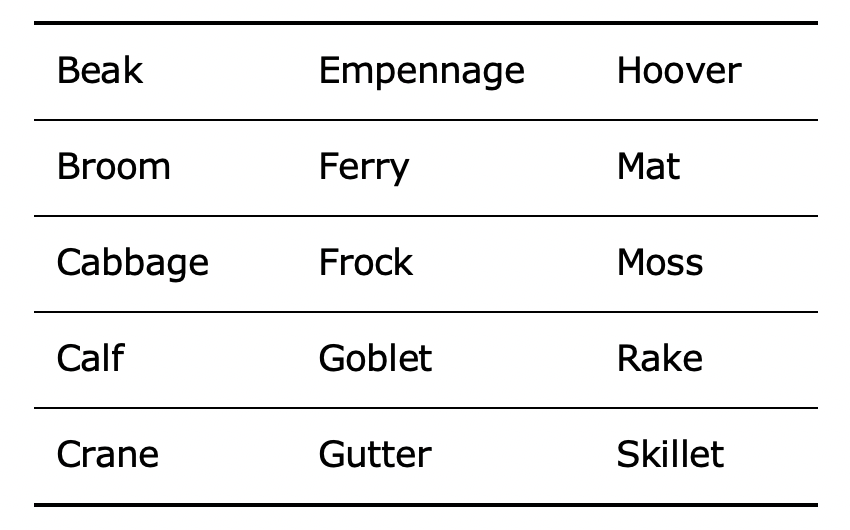
Table 1: Target words
Passive Recall Post-test
Researchers distinguish between passive, or receptive, and active, or productive, knowledge of a word (Meara, 1997; Nation, 2001). Passive knowledge is associated with listening and reading and implies the ability for an individual to comprehend input. In vocabulary knowledge terms, this implies that the learner can perceive the form of a word and understand its meaning or meanings. On the other hand, active knowledge is associated with speaking and writing and implies that an individual is capable of retrieving the appropriate lexical item in order to express it in written or spoken form. There is a difference in the degree of knowledge held by learners who can recall the form and meaning of a word and those who cannot recall them, but can recognize them in a set of options. The former is a more advanced type of knowledge than the latter (Laufer & Goldstein, 2004) as a person who can recall the meaning of a given word is also likely to be able to recognize it among several choices. For the present study, two measures of receptive knowledge were selected since they can be more sensitive to any changes in vocabulary knowledge that may have happened after the treatment was applied. Consequently, the passive recall test sought to demonstrate understanding of the meaning of an L2 lexical item. The L2 word is part of the prompt, and participants had to provide the L1 (Spanish) translation of the word:
Crane → G _____ (grúa)
Passive Recognition Post-test
A more sensitive vocabulary testing method requires the learner to select (i.e., to recognize) the right answer from several choices (Laufer & Goldstein, 2004; Waring, 1997). In a passive recognition test, the target word in the L2 is given as a prompt, and the task of participants is to choose its correct meaning among the four options given. The format of the test was adapted from Laufer and Goldstein (2004) and the guidelines to create the three distractors for each target word were taken from Lee and Pulido (2017). The four options were thus completed as follows:
Frock
a. Falda (A distractor contextually proximate to the target word)
b. Vestido (The correct meaning of the target word)
c. Rana (A distractor phonologically or orthographically close to another know word in the L1 or L2)
d. Galleta (A distractor semantically unrelated to the target word)
Procedures
Pilot Study
The researchers carried out a pilot study with EFL learners who attended the same university and whose L2 language proficiency levels were between A2 and B1. The goal was to identify any flaws or misunderstandings that students could encounter with the instructions and the post-tests. Written feedback provided by these participants suggested that instructions were appropriately understood, and that the time limit for the post-tests was adequate.
Main Study Sessions
In the first session, the researchers presented the study, discussed its objectives, and secured consent. Then, the OQPT was administered to assess English language general proficiency. Finally, participants completed the VKS so as to select the 15 target words. In the second session, the researchers explained the KM and applied the treatment with the two groups that were exposed to it (KM+visual cues and KM with no visual cues). The KM+visual cues group received instruction that included exposition to a picture connecting the L2 word with the keyword. The KM with no visual cues group received a similar explanation of the KM, but they were not exposed to the images. In this case, participants were asked to close their eyes and create mental images with the L2 words and the keywords presented by the researchers. The comparison group, i.e., the group that did not receive any type of mnemonic instruction, was exposed to the same words by means of Rote Learning techniques, which imply teaching lexical items as isolated entities that share no meaningful relationship (Boers et al., 2009). This method is typically utilized in EFL settings and is more prevalent than any other method (Schmitt, 2008). Thus, in the comparison group the researchers showed the target L2 word and immediately provided its translation. The 15 target words were presented in the three groups by following the three distinct approaches, which took 25-30 minutes in each instance. After the intervention, learners were exposed to an unrelated video in order to remove lexical items from short-term memory. Finally, the immediate passive recall and passive recognition tests were applied in order to assess vocabulary gains in the three groups. Two weeks after the intervention, a third session was conducted to assess retention by means of unannounced delayed post-tests (passive recall and passive recognition tests). In order to measure vocabulary gains made by participants in the passive recall and passive recognition post-tests in the three groups, descriptive and inferential statistics were calculated. A Kruskal-Wallis test was applied since the data of the three groups were found to be non-parametric.
Results
Descriptive Data for the Immediate Passive Recall Test
Table 2 shows that the KM+visual cues group (M=12.60), the KM with no visual cues group (M=12.43), and the Rote Learning group (M=13.13) performed similarly in the immediate passive recall test. Even though the comparison group slightly outperformed the KM groups, the means suggest that none of the three groups was superior in this measure.
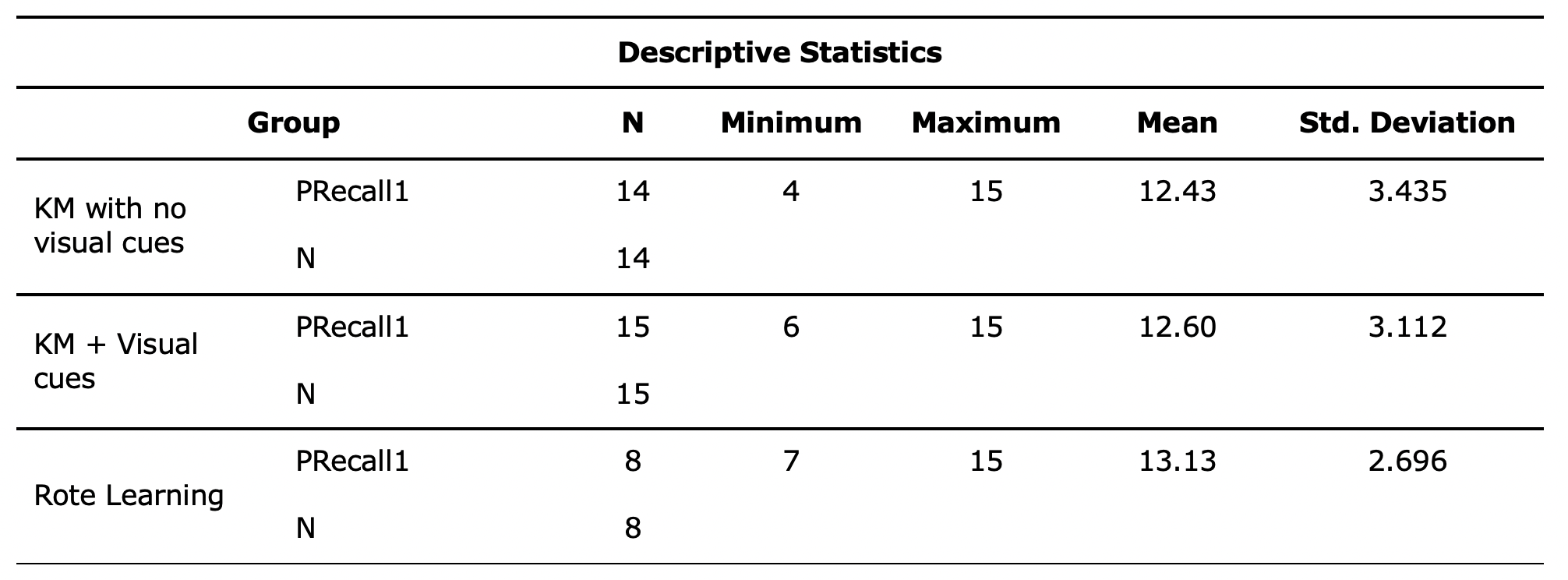
Table 2: Descriptive statistics for immediate passive recall test
Descriptive Data for the Delayed Passive Recall Test
Table 3 below shows that participants in the three groups remembered fewer words than in the immediate passive recall test, which was expected due to the more sensitive nature of the passive recognition test, particularly when assessing retention. In this measure, however, the lowest score group was the KM+visual cues group (M=5.47), when compared to the KM with no visual cues group (M=7.21) and the comparison group (M=7.13).
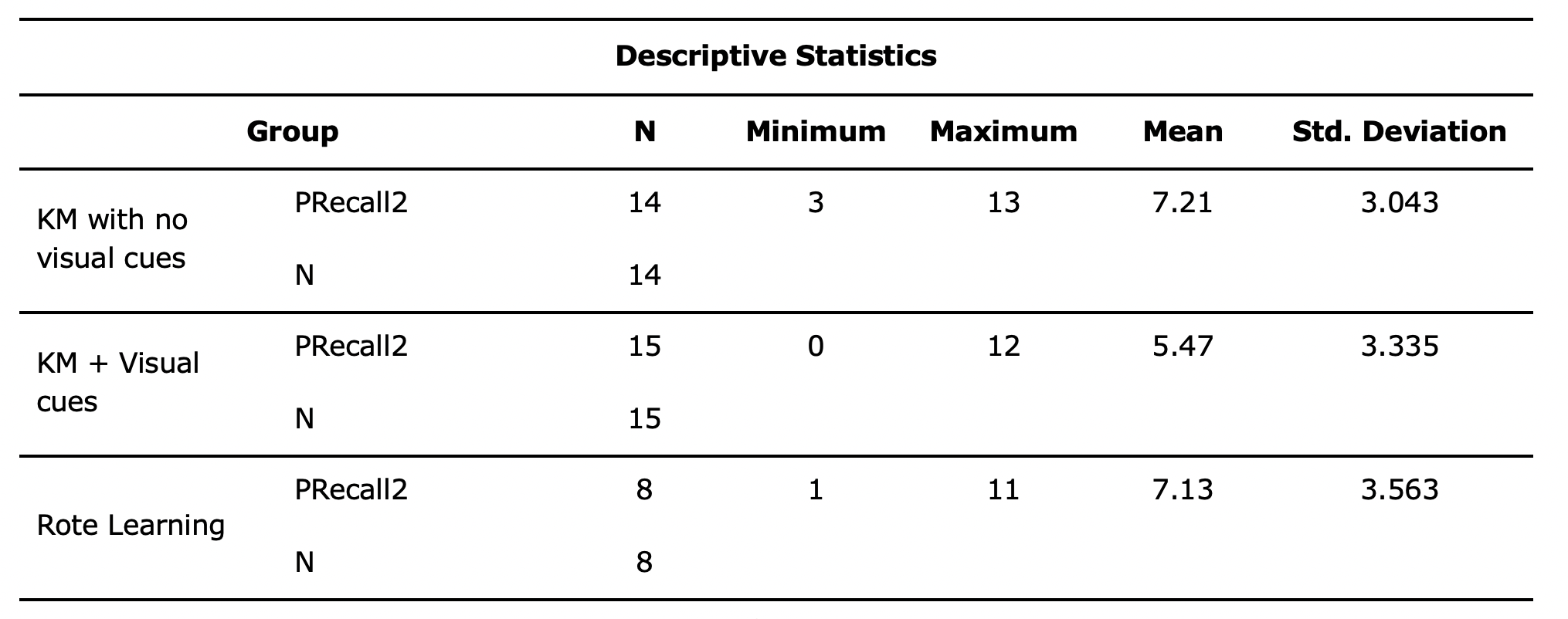
Table 3: Descriptive statistics for the delayed passive recall test
Descriptive Data for the Immediate Passive Recognition Test
In Table 4, it can be seen that the three groups produced similar means that were high, which is in line with immediate results in the immediate passive recall test. The high means in the three groups (between M=14.27 and M=14.86, out of 15) suggest that a ceiling effect may have taken place. This can be explained by the intentional nature of the approach, together with the immediate nature of the testing in this particular measure.
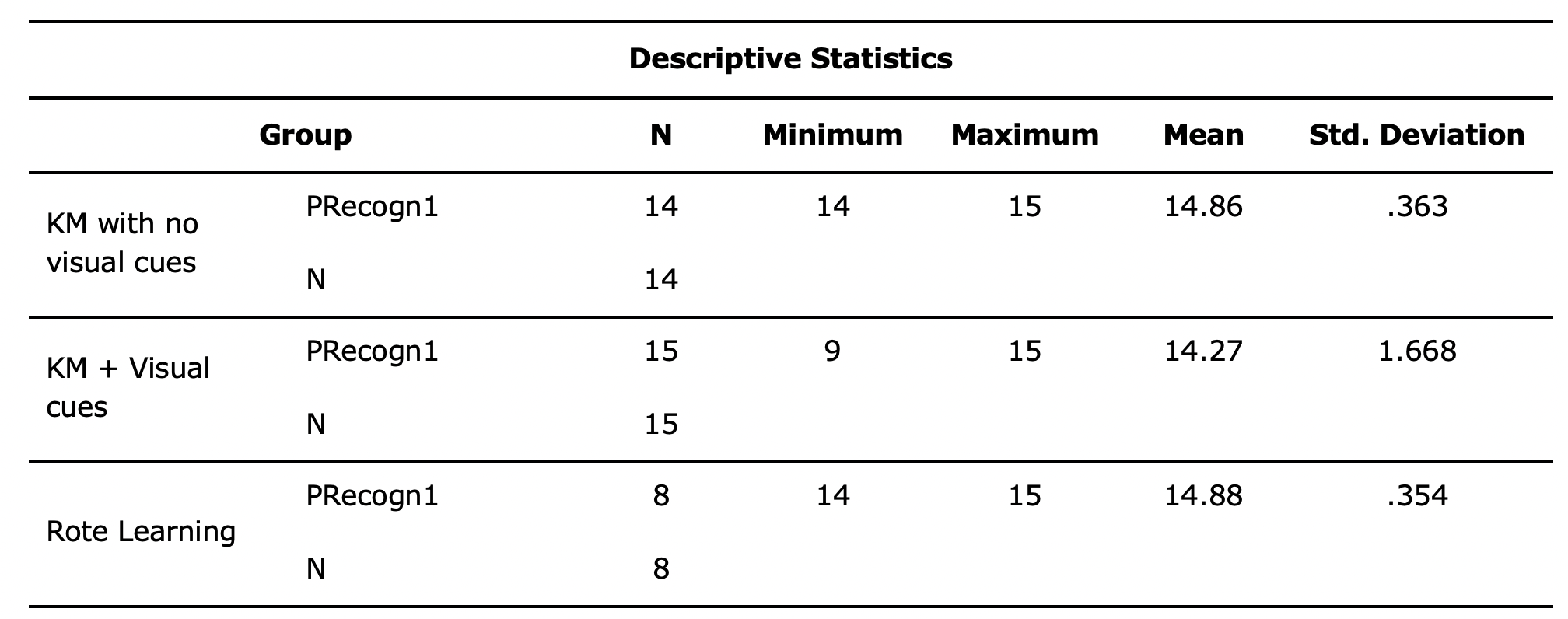
Table 4. Descriptive statistics for immediate passive recognition test
Descriptive Data for the Delayed Passive Recognition Test
Finally, Table 5 below shows that, unlike passive recall results, scores in the delayed passive recognition test were mostly maintained three weeks after the treatment. The KM+visual cues group had the lowest mean (M=13.07), followed by the comparison group (M=14.13) and the KM with no visual cues group (M=14.21). There was a tendency for the KM+visual cues group to produce the lowest scores in immediate and delayed post-test in both instruments.
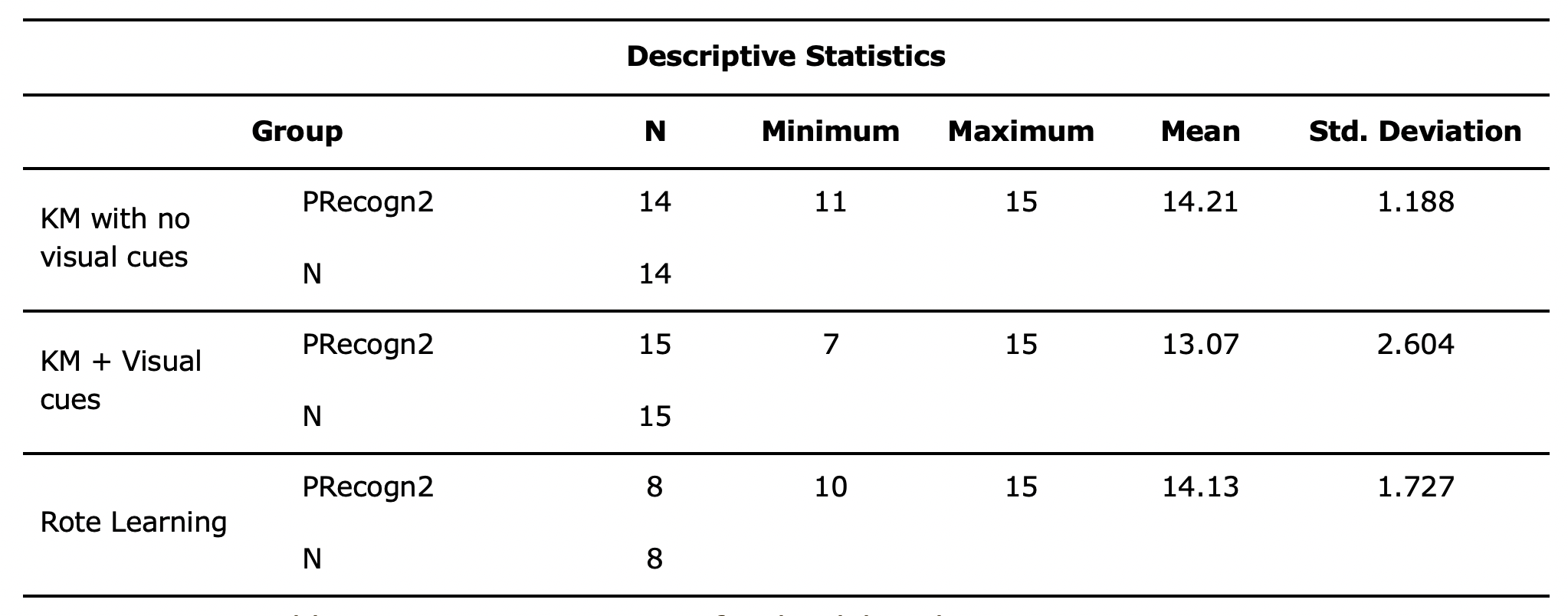
Table 5. Descriptive statistics for the delayed passive recognition test
Inferential Statistics
The Kruskal-Wallis test (Table 6) ran with the data showed that there were no significant differences (p > 0.05) between the three groups in any of the four outcome measures. Even though the differences between the means were not found to be significant, there is a tendency for the KM with no visual cues group to outperform the KM+visual cues group. This was seen in both immediate and delayed post-tests (passive recall and passive recognition). This may be explained to some extent by the idea that participants who create the mental image in their minds without the help of visual cues may have developed a stronger cognitive attachment to the mental images they create. As Egan and Judson (2016) argue, self-created mental images can have a stronger impact on memory than visual cues.
|
|
PRecall1 |
PRecogn1 |
PRecall2 |
PRecogn2 |
|
Chi-Square |
.050 |
1.245 |
2.468 |
2.470 |
|
df |
2 |
2 |
2 |
2 |
|
Asymp. Sig. |
.975 |
.537 |
.291 |
.291 |
|
||||
Table 6. Test statistics for Kruskal-Wallis
Discussion
Research question 1: Does a version of the Keyword method involving visual cues promote more vocabulary learning and retention in EFL learners than a version without them?
The first research question sought to assess whether a version of the Keyword method with visual cues could more effectively prompt cognitive processes in vocabulary learning than a version of the method that did not include them. Statistical results showed that there were no meaningful differences between the two versions of the Keyword method, thus suggesting that visual cues were not crucial in the effectiveness of the Keyword method. It must be noted that the version of the Keyword method with no visual cues consistently produced better scores in comparison to the version with visual cues. Even though the results of the delayed passive recall post-test showed that there was a difference of 1.74 points between the means in the two Keyword method groups, this difference did not reach significance. These findings are in contrast with the results reporting that visual cues need to be present in the Keyword method in order to prompt deeper cognitive processing and thus higher retention of new vocabulary (Dolean, 2014). Results in the present study imply that using the Keyword method without visual cues may prompt similar cognitive processes as a version with visual cues. Learning may take place even when learners’ mental images do not result from the visual links to which they are exposed, but result from the strength of the mental image that is created by learners, which may or may not include external visual stimuli. The evidence presented points to the idea that the vocabulary learning achieved by visual cues can be at least as high as the gains made in a version of the Keyword method without them. Thus, having visual cues to create mental images in this method may not be necessary to promote more vocabulary acquisition in the language classroom.
Research question 2: Does the Keyword method promote more vocabulary learning and retention than rote Learning in EFL learners?
Results showed no statistical differences among the three groups in the two measures assessed. That is to say, the comparison group did not perform differently in comparison to the two versions of the Keyword method. Statistical results also demonstrate that the Rote Learning approach applied in the comparison group to learn the 15 target words did not yield lower scores than the approaches in the groups that included the Keyword method. These results were maintained in the delayed measures, with the three groups decreasing their vocabulary scores, but still not showing significant differences between them. This suggests that traditional Rote Learning methods for L2 vocabulary learning may have similar effects in EFL settings when the goal is to intentionally teach a specific number of lexical items. This is in line with findings showing that the Keyword method may not be superior to Rote Learning and retention in these learning circumstances (van Hell & Mahn, 1997). It is possible that the wide array of procedures and testing instruments used in assessing mnemonic approaches such as the Keyword method (Wyra et al., 2007) may influence the effects that the creation of mental images may have on learners’ cognitive processes.
Even though research advocates in favour of more dynamic and engaging methods for L2 vocabulary learning in EFL and ESL settings (Fritz et al., 2007), results in the present study seem to suggest that Rote Learning tasks can still be used as an effective L2 vocabulary learning tool when the goal is to promote intentional learning of a list of words. Overall, results have shown that visual cues in the Keyword method did not prove to be more beneficial to the learning and retention of 15 unknown target words than using no visual cues, and that the Keyword method did not promote more vocabulary learning and retention than Rote Learning.
Conclusion
The present study sought to compare two different versions of the Keyword method (KM+visual cues and KM with no visual cues) and to assess the effectiveness of the two Keyword method groups when compared to a group using Rote Learning. Immediate and delayed post-test data (passive recall and passive recognition) showed that there were no significant differences in the three groups across outcome measures. A trend was acknowledged where the version of the Keyword method with no visual cues consistently had higher scores than the other version of the Keyword method. That is, when participants were asked to create their own mental image with the L2 words and the keywords, they tended to remember and retain more words than learners who were given visual cues prompted by a teacher. As for the comparison group using Rote Learning, it repeatedly outperformed the other two groups which underscored the effectiveness of rote rehearsal in the learning and retention of a list of unknown words.
As other researchers have pointed out, the differences in approaches and instruments in the assessment of the Keyword method may affect the results obtained. Therefore, it becomes necessary to exercise caution when generalising results. In addition, more participants in each group would have provided more statistical power to detect significant differences in relation to the trend identified between groups. Research designs that include retention suffer from learner attrition, which may increase when students are required to sit for other tests and exams as part of their programmes. Thus, in order to explore the trends identified in the findings, further research should be done to take into account these limitations.
Implications for Pedagogy
The implications for pedagogy that arise from the reported findings may be discussed in terms of the mnemonic methodologies that teachers utilize in their classes. Teachers can deliver a more dynamic class by using different approaches to vocabulary learning. These approaches should involve several perspectives, including the creation of mental images by means of different “cognitive triggers.” This will depend on the number of vocabulary items that students need to learn at a particular pedagogical juncture. Furthermore, if visual cues are not crucial to promoting mental image creation in the Keyword method, EFL/ESL teachers do not need to create them every time they want learners to generate a mnemonic link between the L2 word and the keyword. An adequate verbal prompt to create a mental image may be just as effective as the time-consuming creation and presentation of a picture when the pedagogical goal is to learn and retain a discrete amount of unknown words. It must be noted that for any version of the Keyword method to be effective in the EFL classroom, teachers should make sure that a mental image is created in their learners’ minds when the pedagogical goal is to learn a set of lexical items.
References
Algozzine, B., & Douville, P. (2004). Use mental imagery across the curriculum. Preventing School Failure: Alternative Education for Children and Youth, 49(1), 36-39. https://doi.org/10.3200/PSFL.49.1.36
Atkinson, R. C., & Raugh, M. R. (1975). An application of the mnemonic keyword method to the acquisition of a Russian vocabulary. Journal of Experimental Psychology: Human Learning and Memory, 104(2), 126-133.
Baleghizadeh, S., & Ashoori, A. (2010). The effect of keyword and word-list methods on immediate vocabulary retention of EFL learners. Pakistan Journal of Social Sciences (PJSS), 30(2), 251-261. http://pjss.bzu.edu.pk/website/journal/article/5e95531813732/file/5e95536a5307b/view
Barahona, M. (2015). English language teacher education in Chile: A cultural historical activity theory perspective. Routledge.
Boers, F., Piquer Píriz, A. M., Stengers, H., & Eyckmans, J. (2009). Does pictorial elucidation foster recollection of idioms?. Language Teaching Research, 13(4), 367-382. https://doi.org/10.1177%2F1362168809341505
Bruton, A. (2009). The Vocabulary Knowledge Scale: A critical analysis. Language Assessment Quarterly, 6(4), 288-297. https://doi.org/10.1080/15434300902801909
Cancino, M. (2020). Increasing EFL learner participation through eliciting language: Insights from conversation analysis. Journal of Language and Education, 6(2), 76-90. https://doi.org/10.17323/jle.2020.10304
Cuevas, J., & Dawson, B. L. (2018). A test of two alternative cognitive processing models: Learning styles and dual coding. Theory and Research in Education, 16(1), 40–64. https://doi.org/10.1177%2F1477878517731450
Davoudi, M., & Yousefi, D. (2016). The effect of keyword method on vocabulary retention of senior high school EFL learners in Iran. Journal of Education and Practice, 7(11), 106-113. https://www.iiste.org/Journals/index.php/JEP/article/view/29852/30664
Díaz Larenas, C., & Morales Campos, H. (2015). Creencias de estudiantes de primaria sobre el aprendizaje del inglés en un establecimiento educacional chileno [Elementary students’ beliefs about EFL learning at a Chilean school]. Revista Actualidades Investigativas en Educación, 15(1), 1–21. https://revistas.ucr.ac.cr/index.php/aie/article/view/17730/17299
Dolean, D. D. (2014). Using the keyword method in the classroom: Is the interacting imagery necessary? System, 45, 17- 26. https://doi.org/10.1016/j.system.2014.04.003
Egan, K., & Judson, G. (2016). Imagination and the engaged learner: Cognitive tools for the classroom. Teachers College Press.
Ellis, N., & Beaton, A. (1993). Factors affecting the learning of foreign language vocabulary: Imagery keyword mediators and phonological short-term memory. The Quarterly Journal of Experimental Psychology, 46(3), 533-558. https://doi.org/10.1080/14640749308401062
Fritz, C. O., Morris, P. E., Acton, M., Voelkel, A. R., & Etkind, R. (2007). Comparing and combining retrieval practice and the keyword mnemonic for foreign vocabulary learning. Applied Cognitive Psychology, 21(4), 499-526. https://doi.org/10.1002/acp.1287
Geranpayeh, A. (2003). A quick review of the English Quick Placement Test. Research notes, 12, 8-10.
Glas, K. (2008). El inglés abre puertas. . . ¿a qué? Análisis del discurso sobre la enseñanza del inglés en Chile, 2003–2006 [English Open Doors… To what? A discourse analysis of EFL teaching in Chile, 2003-2006]. Revista Educación y Pedagogía, 20(51), 11–122. https://revistas.udea.edu.co/index.php/revistaeyp/article/view/9900/9096
Gómez Burgos, E., & Pérez Pérez, S. (2015). Chilean 12th graders' attitudes towards English as a foreign language. Colombian Applied Linguistics Journal, 17(2), 313-324. https://doi.org/10.14483/udistrital.jour.calj.2015.2.a10
Higbee, K. L. (2001). Your memory: How it works and how to improve it. Marlowe.
Hodes, C. L. (1998). Understanding visual literacy through visual informational processing. Journal of Visual Literacy, 18(2), 131-136. https://doi.org/10.1080/23796529.1998.11674534
Kavale, K. A., & Forness, S. R. (2000). Policy decisions in special education: The role of meta-analysis. In R. M. Gersten, E. P. Schiller, & S. Vaughn (Eds.), Contemporary special education research: Syntheses of the knowledge base on critical instructional issues (pp. 281–326). Erlbaum.
Laufer, B., & Goldstein, Z. (2004). Testing vocabulary knowledge: Size, strength, and computer adaptiveness. Language Learning, 54(3), 399–436. https://doi.org/10.1111/j.0023-8333.2004.00260.x
Lee, S., & Pulido, D. (2017). The impact of topic interest, L2 proficiency, and gender on EFL incidental vocabulary acquisition through reading. Language Teaching Research, 21(1), 118 –135. https://doi.org/10.1177%2F1362168816637381
Luo, M. N., & Huang, M. (2019). ESL teachers’ multiple intelligences and teaching strategies: Is there a linkage? TESOL Journal, 10(1). https://doi.org/10.1002/tesj.379
Marland, K. (2002). High frequency words: Strategies that build skills in spelling, vocabulary, and word play. Pembroke.
Matear, A. (2008). English language learning and education policy in Chile: Can English really open doors for all? Asia Pacific Journal of Education, 28(2), 131-147. https://doi.org/10.1080/02188790802036679
Meara, P. (1997). Towards a new approach to modelling vocabulary acquisition. In N. Schmitt & M. McCarthy (Eds.), Vocabulary: Description, acquisition and pedagogy (pp. 109-121). Cambridge University Press.
Miller, G., & Obara, S. (2017). Finding meaning in mathematical mnemonics. The Australian Mathematics Teacher 73(3), 13. https://search.informit.com.au/documentSummary;dn=123454825592296;res=IELHSS
Ministerio de Educación República de Chile (2016). Bases Curriculares 7º y 8º básico / 1º y 2º medio. https://media.mineduc.cl/wp-content/uploads/sites/28/2017/07/Bases-Curriculares-7%C2%BA-b%C3%A1sico-a-2%C2%BA-medio.pdf
Muñoz, J. E., & Mora, Y. F. (2006). Functions of code-switching: Tools for learning and communicating in English classes. How, 13(1), 31-45. https://www.howjournalcolombia.org/index.php/how/article/view/106
Nation, I. S. P. (2001). Learning vocabulary in another language. Cambridge University Press.
Ożańska-Ponikwia, K. (2015). The role of mnemonics in the process of L1 and L2 language learning. Zeszyty Naukowe Wyższej Szkoły Humanitas. Pedagogika, (10), 93-100.
Paivio, A. (1971). Imagery and verbal processes. Holt, Rinehart and Winston.
Pearson, J., Naselaris, T., Holmes, E. A., & Kosslyn, S. M. (2015). Mental imagery: Functional mechanism and clinical applications. Trends in Cognitive Sciences, 19(10), 590-602. https://doi.org/10.1016/j.tics.2015.08.003
Rieder-Bünemann, A. (2012). Mnemotechnics in second language learning. Encyclopedia of sciences of learning. In N. M. Seel (Ed.). Encyclopedia of the sciences of learning. Springer. https://doi.org/10.1007/978-1-4419-1428-6_789
Sagarra, N., & Alba, M. (2006). The key is in the keyword: L2 vocabulary learning methods with beginning learners of Spanish. The Modern Language Journal, 90(2), 228–243. https://doi.org/10.1111/j.1540-4781.2006.00394.x
Sarıçoban, A., & Başıbek, N. (2012). Mnemonics technique versus Context Method in teaching vocabulary at upper-intermediate level, EÄŸitim Ve Bilim, 37(164), 251-266. http://egitimvebilim.ted.org.tr/index.php/EB/article/view/783/377
Schmitt, N. (2008) Instructed second language vocabulary learning. Language Teaching Research, 12(3), 329-363. https://doi.org/10.1177%2F1362168808089921
Schmitt, N. (2014). Size and depth of vocabulary knowledge: What the research shows. Language learning, 64(4), 913-951. https://doi.org/10.1111/lang.12077
Schunk, D. H. (2012). Learning theories: An educational perspective (6th ed.). Pearson.
Shaman, S. N. (2015). Using the expanded Keyword Method to help K-12 students develop vocabulary knowledge [Unpublished doctoral dissertation]. Washington State University. https://research.wsulibs.wsu.edu:8443/xmlui/handle/2376/5443
Shapiro, A. M., & Waters, D. L. (2005). An investigation of the cognitive processes underlaying the keyword method of foreign vocabulary learning. Language Teaching Research, 9(2), 129-146. https://doi.org/10.1191%2F1362168805lr151oa
University of Cambridge Local Examinations Syndicate, (2001). Quick placement test: Paper and pen version pack. Oxford University Press.
van Hell, J. G., & Mahn, A. C. (1997). Keyword mnemonics versus rote rehearsal: Learning concrete and abstract foreign words by experienced and inexperienced learners. Language Learning, 47(3), 507–546. https://doi.org/10.1111/0023-8333.00018
Waring, R. (1997). A comparison of the receptive and productive vocabulary sizes of some second language learners. Immaculata: The occasional papers at Notre Dame Seishin University, Okayama, 53-68. http://www.robwaring.org/papers/various/vocsize.html
Wesche, M., & Paribakht, T. S. (1996). Assessing second language vocabulary knowledge: Depth versus breadth. Canadian Modern Language Review, 53(1), 13-40. https://doi.org/10.3138/cmlr.53.1.13
Wyra, M., Lawson, M. J., & Hungi, N. (2007). The mnemonic keyword method: The effects of bidirectional retrieval training and of ability to image on foreign language vocabulary recall. Learning and Instruction, 17(3), 360-371. https://doi.org/10.1016/j.learninstruc.2007.02.008
Zahedi, K., & Fallah, N. (2011). The relationship between vocabulary knowledge, linguistic intelligence and morphological awareness among EFL learners. Academic Leadership: The Online Journal, 9(1). https://scholars.fhsu.edu/alj/vol9/iss1/49

